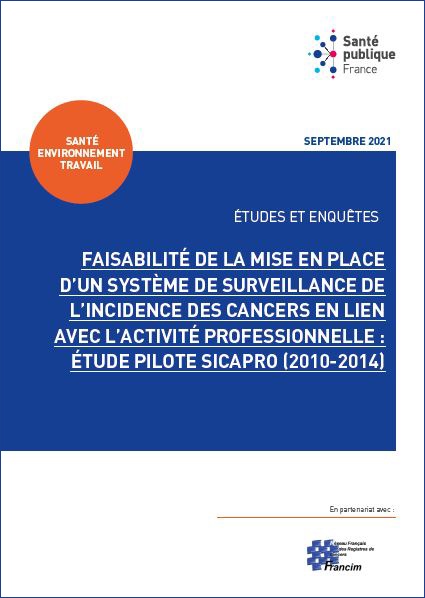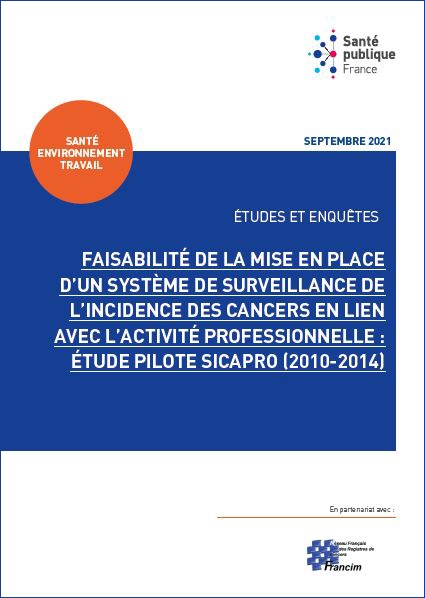
This report presents the results of the study on the feasibility of setting up a monitoring system for the incidence of cancers linked to professional activity. There is currently no monitoring system of this type in France. Estimates of the incidence of cancers by profession or sector of activity represent information of interest for the description and understanding of the relationships between occupational risk factors and the appearance of cancer in the French population. They would make it possible to identify professions or sectors of activity with a high incidence of cancer and changes over time, in order to guide public policies intended to improve and evaluate the prevention and recognition of work-related cancers. . The envisaged system for monitoring the incidence of cancers linked to professional activity (Sicapro), the main objective of which is to identify professional groups at increased risk of cancer, is based on the coupling at the individual level, of medical data from cancer registers with data on professional careers from the National Old Age Insurance Fund (Cnav). As a first step, in order to test the feasibility of setting up such a monitoring system, a pilot study was carried out with two voluntary registers (General cancer register of Lille and its region and Doubs tumor register et du Territoire de Belfort) who provided data on all cancer cases recorded for the years 2010-2014. The objectives of this pilot study were to study the performance of the matching using data on the civil status of people with cancer from registers and those appearing in CNAV data; to identify the professional history data available in the CNAV databases and to study the quality of this administrative data for the purpose of epidemiological surveillance; to develop the various indicators that could be constructed routinely for the final monitoring system and to study the limits of the approach, particularly in the identification of occupational exposure. Since the 1970s, there have been general or specialized cancer registers in France which allow local and national epidemiological surveillance of cancers by exhaustively recording all cases of cancer occurring among the population residing in the territory covered by each register. . General cancer registries collect information on all cancers, while specialized cancer registries collect extensive information on certain cancers (digestive system, hematological malignancies, breast and other gynecological cancers, central nervous system, thyroid, mesothelioma or concerning populations (children and adolescents).The two volunteer cancer registries to take part in this pilot study (Lille and its region; Doubs and Territoire de Belfort) are general registries, integrating all cancer locations. the Cnav contain all the data inherent to the career of the insured in order to calculate their retirement.Are included are all persons having at least one period of activity giving rise to contribution to the general scheme regardless of the duration and concerns the all individuals who have worked or are working in metropolitan or overseas France, including the foreign population. Information feedback from other affiliation schemes (Agricultural social mutual insurance scheme, Social scheme for the self-employed, etc.) is fed back in order to allow the calculation of pension rights, generally when approaching retirement, at the end of careers. The matching of the data was carried out by the National Old Age Insurance Fund on the civil status data (surname, first name, date and town of birth) in the absence of the collection of the registration number in the national directory of identification of natural persons (NIR) by cancer registries. The performance of this pairing was satisfactory since 96.9% of cancer cases were found in the Cnav databases. The reconstruction of career histories was carried out using employer numbers, the sector of activity directly accessible via the code of main activity exercised being only systematically entered for the most recent years. The enterprise number (Siret) collected in the database makes it possible to find the sector of activity (NAF) of the company via the Insee Sirene® database. The feasibility of reconstructing the professional history with a view to measuring associations between the occurrence of cancer and sector of activity also proved satisfactory from the year 1999. From the incident cases of 2019 , we will therefore have a reliable professional history over the last twenty years of careers, which seems sufficient even for studies relating to diseases with long latency periods such as cancers. The information of the socio-professional category (CSP) by the employers is compulsory from the year 2008 but problems of feedback of information for the years 2009 to 2011 did not make it possible to provide indicators within the framework of this pilot study. Nevertheless, this information can be used from the year 2012 and will provide indicators of cancer incidence by CSP at the time of diagnosis for the extended surveillance system Finally, two examples of possible use of these data are presented here. The first study presents the standardized incidence ratios of lung cancer according to the sector of activity occupied at the time of diagnosis in cases aged 20 to 64 and recorded between 2010 and 2014 by the cancer registry of Doubs and the territory. of Belfort. The second is a case-control study estimating the risk of occurrence of lung cancer for the entire career for the two registers by considering as exposed individuals who have worked at least one year versus individuals who have worked less than one year for each sector of activity. These results are put into perspective with the calculation of indices of disparity in expected incidence due to differences in the prevalence of smoking by activity sector, tobacco remaining the main risk factor for lung cancer. The main limitation identified during this study is related to the population covered by the National Old Age Insurance Fund. In fact, the CNAV only covers employees under the general scheme and the returns from other schemes are therefore only complete for retired individuals. In addition, the information reported by the other schemes does not make it possible to reconstruct the sectors of activity occupied during the career or the CSPs for the periods when the individuals were self-employed or employees contributing to another scheme. This limit could be lifted by the implementation by the CNAV of the single career management directory (RGCU) aimed at pooling the data relating to the career of each insured from all the schemes in order to ensure the completeness and consistency of this data. Feeding the RGCU in real time by the other plans, set for December 31, 2022, could thus make it possible to extend the population covered by the monitoring system to all working people, regardless of the affiliation plan. Despite the limitations highlighted during this pilot phase, the Sicapro monitoring system has the properties of an effective monitoring system: it does not require the collection of additional data, high sensitivity because the registers exhaustively collect the incident cases in their area and it is representative of the general scheme employee population. The inclusion of all cancer registries in the surveillance system, covering nearly 20% of the population, will allow greater power allowing a study of incidence for rarer cancer locations and/or for sectors activity at a finer level. The surveillance system will also make it possible to produce indicators at a departmental level for the departments entirely covered by a register, including for certain overseas departments (Guadeloupe, Martinique and Guyana).
Author : Lapostolle Annabelle
Year of publication: 2021
Pages: 60 p.
Collection : Studies and surveys













